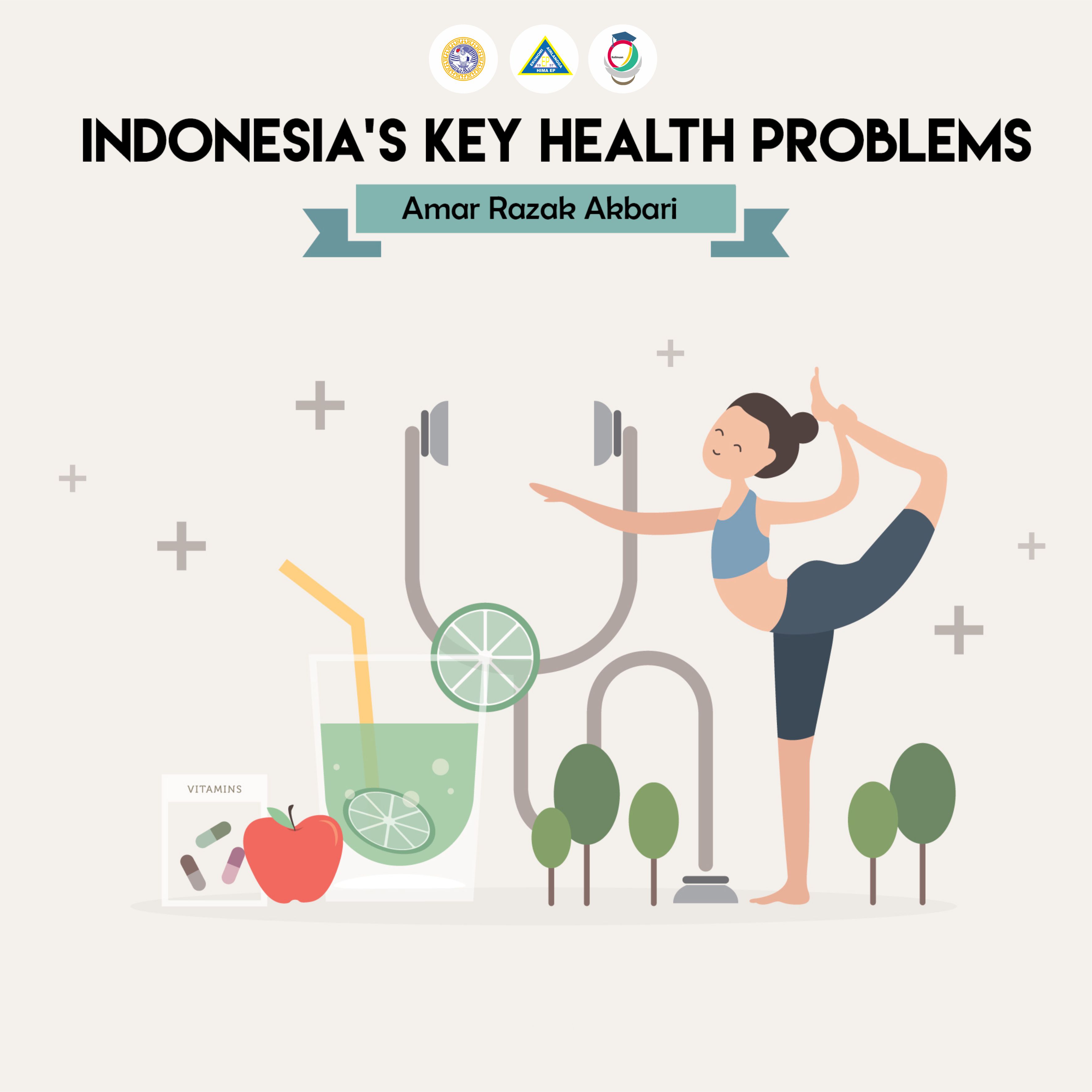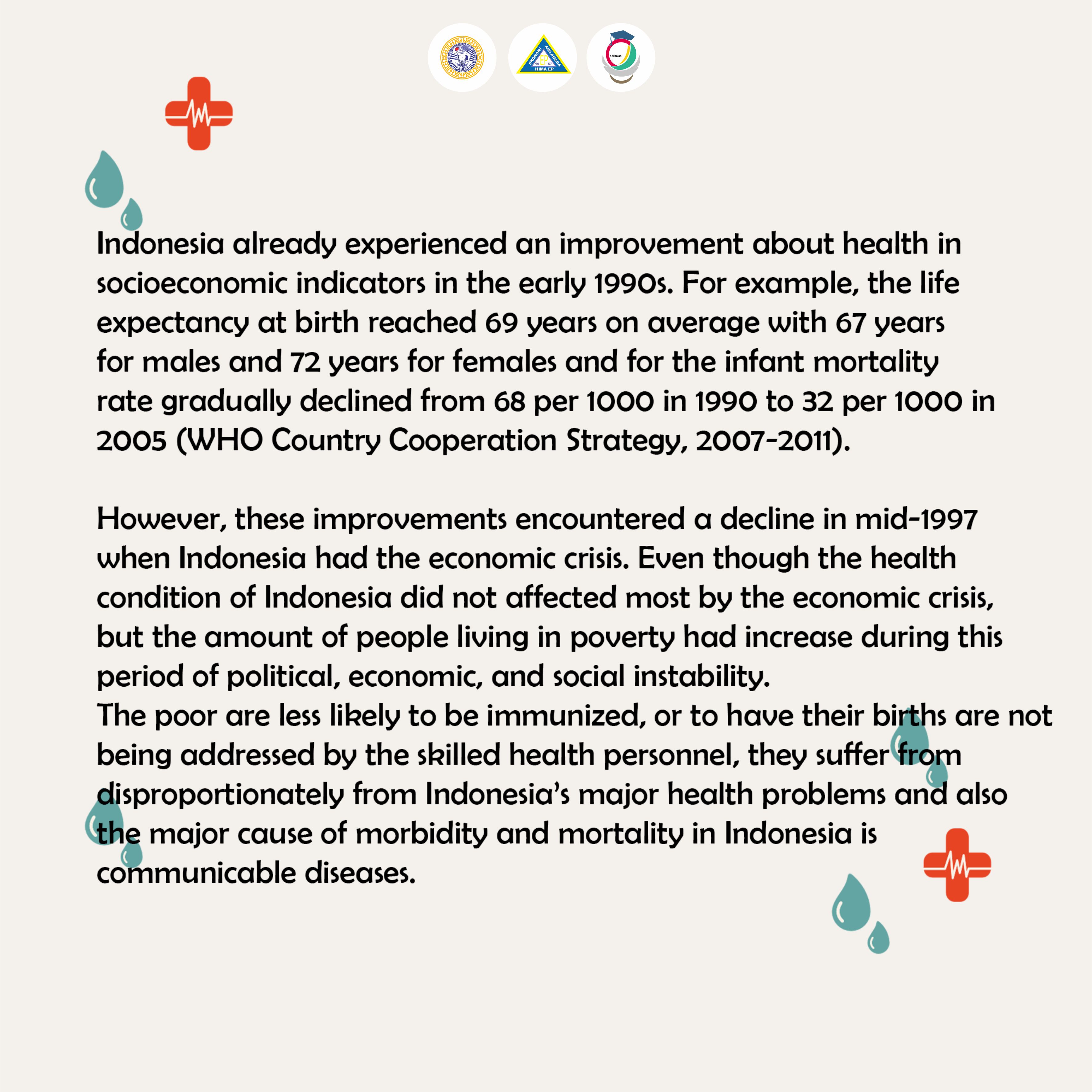Indonesia’s Key Health Problems
By: Amar Razak Akbari
Indonesia already experienced an improvement about health in socioeconomic indicators in the early 1990s. For example, the life expectancy at birth reached 69 years on average with 67 years for males and 72 years for females and for the infant mortality rate gradually declined from 68 per 1000 in 1990 to 32 per 1000 in 2005 (WHO Country Cooperation Strategy, 2007-2011). However, these improvements encountered a decline in mid-1997 when Indonesia had the economic crisis. Even though the health condition of Indonesia did not affected most by the economic crisis, but the amount of people living in poverty had increase during this period of political, economic, and social instability. The poor are less likely to be immunized, or to have their births are not being addressed by the skilled health personnel, they suffer from disproportionately from Indonesia’s major health problems. Before the fifth birthday, children from the poorest families are approximately four times more likely to die before their fifth birthday than children from the richest families.
Non-communicable disease are increasingly while communicable disease still remain an important part of the disease burden. For example, cardiovascular disease such as diabetes account for 30 percent of deaths in Java and Bali. Indonesia also join among the ten countries in the world with the highest rates of diabetes incidence. Another example, according to the Indonesia Demographic and Health Survey, in 2002 to 2003, the highest maternal mortality in the South-East Asia Region is in Indonesia with 307/100.000 live births. Compared with Thailand, the lifetime risk of a mother dying of causes related to childbirth in Indonesia is estimated to be 1 in 65 while in Thailand obtained 1 in 1000 (WHO, 2002).
The major cause of morbidity and mortality in Indonesia is communicable diseases. Every day, approximately 300 people die because of tuberculosis (WHO Report 2006: Global tuberculosis control – surveillance, planning and financing, 2006). The plague of HIV affects the most productive members in
the society, which is the young people and wage-earners. According to UNAIDS, an estimated 53.000 to 180.000 Indonesians were living with HIV-AIDS at the end of 2003. Another challenges that Indonesia must face is to reduce the consumption of tobacco in the society, in fact that tobacco is the second most important cause of morbidity and mortality.
The inequalities in Indonesia comes from many reasons, one of them is those people who live in rural locations are poor. Incomes of those who live in the city still much higher than the rural incomes, this leads to many poorer health outcomes in many ways. First of all, rural people have less money to afford for their healthcare. However, because rural areas spend less money on healthcare, there are fewer health providers that become attracted to provide any healthcare in the rural areas. Indonesia’s unique geography just made the rural areas became difficult to reach, since nearly 18,000 islands which around
6,000 are inhabited, the population is highly dispersed and hard to reach. Without proper physical infrastructure such as roads which is often missing or broke in the rural areas, it makes it harder to connect the inhabitants to the central health facilities, and also postponed the supply of medicines and
health equipment. Furthermore, managing health in rural communities will become harder since rural communities tent to have lower levels of education. Many studies have proven that education of girls is very important, with educating girls comes smaller families with better health and higher incomes.
Improving health services for those who live in rural areas is crucial. According to Firman Lubis, a medical professor at the University of Indonesia, one of the fundamental human right is the access to good healthcare and those who live in rural areas tend to come from lower socio-economic backgrounds, which makes them more vulnerable to tragic healthcare costs when disease strikes. Since the financial crisis in 1998, a daily income of less than US $1 has been decline, but rising wealth has barely reduce people’s exposure to the dangers of unexpected health expenditure, plus, these people are often uneducated about how to manage their own health, and they think that by experiencing some unexpected disease that force them to face unanticipated medical costs will bring them back to below the poverty line. Indonesia need to fight the inequality in its healthcare system and raise standards of care in rural locations to match those received in urban environment, since 55% of Indonesians still living in rural areas.
Universal coverage, the main goal from the government that involves both putting in place a set of service that make healthcare available to everyone and also setting up the means to finance such services. Financing and services are the aspects that Indonesia has historically struggled. There are many ways to accomplish financing for universal coverage, ranging from systems that are completely covered by government tax revenues, to those that are funded through private contributions by workers into government schemes and the last is systems based around citizens buying cover from private health insurers. Avoid people making out-of-pocket payments at the moment when they need medical attention is the main target of this universal coverage. The fact is, in some low-income countries, OOP payments can ruin a family financial that unprotected by health insurance. But, no matter how well the universal coverage is funded, how to provide the services that will go with it is still an important question. Upgrading health services is a difficult task, and also the critical importance is improving healthcare personnel across the country, not only the number of staff, but include their distribution and quality.
To conclude, the key to helping Indonesia surmount its healthcare challenges is to find and expand innovations to reduce the cost of healthcare technology for example investment in infrastructure such as basic water supply or sanitation. The importance of prevention better than cure should be the
basic on people’s mind, but beside focusing on prevention, acknowledge education about nutrition and family planning would bring a big benefits than building landmark facilities, since health can be achieve starting from ourselves then spread to family and to the communities.
Reference Lists
The World Bank: Improving Indonesia’s Health Outcomes, available at:
http://siteresources.worldbank.org/INTEAPREGTOPHEANUT/Resources/health.pdf
World Health Organization: Country Cooperation Strategy at a Glance, available at:
http://www.who.int/countryfocus/cooperation_strategy/ccsbrief_idn_en.pdf
World Health Organization: WHO Country Cooperation Strategy 2007-2011, available at:
http://www.who.int/countryfocus/cooperation_strategy/ccs_indonesia_2007_2011_en.pdf
Economist Intelligence Unit: Old problems, fresh solutions: Indonesia’s new health regime, available at:
http://files.gecompany.com/healthymagination/pdfs/GE_Indonesia_Sep21.pdf

